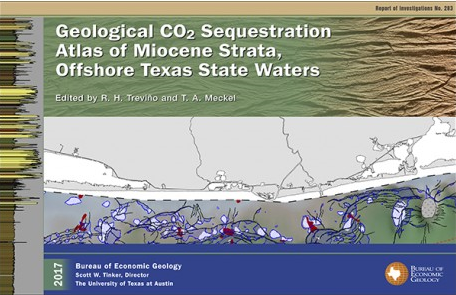Composite Confining Systems
Principal Investigator: Alex Bump
2022–Present Project Overview
Petroleum experience is a valuable source of insight for CCS. It proves permanent geologic storage of buoyant fluids, and it gives us a model for storage—indeed, depleted hydrocarbon fields work for CCS. But is that the best model for CCS? The goals of production and sequestration are fundamentally different.
- Production favors tall traps, high-quality reservoirs and sharp contact with an impermeable seal, all of which help to maximize recovery.
- Sequestration can use those same play elements, but they are not available everywhere and security is maximized with low-relief traps and poor-quality reservoirs, both of which serve to immobilize CO2.
If you can immobilize CO2 in the reservoir, do you really need a completely impermeable, petroleum-type seal? That is the idea behind Composite Confinement, which we define as a thick system of discontinuous barriers to vertical flow, with no a-priori requirements for lateral continuity or capillary entry pressure. In aggregate, the system of barriers creates a long, tortuous flow path for vertical migration that attenuates the mobile CO2 fraction through residual trapping, dissolution, local capillary trapping and distributed buoyant traps. In petroleum terms, it’s migration loss. In CCS terms, it’s ultra-secure storage.
Our work shows that any reduction in permeability (increase in capillary entry pressure) is enough to divert the vertical flow of CO2 at buoyancy pressure, so long as there is no trap (column height). Characterization of Gulf Coast deltaic reservoirs shows that such barriers are abundant—to the point that the effective vertical permeability of the system is on the order of 0.0005 times the horizontal permeability. Our efforts to “fail” models of these systems by over-injecting end up losing CO2 out the sides of the model every time. For flat or low-dip systems, composite confinement can be incredibly effective.

In the News
Better Carbon Storage with Stacked Geology
Learn More
This publication is a great place to start reading about Composite Confining Systems:
Bump, A.P., Bakhshian, S., Ni, H., Hovorka, S.D., Olariu, M.I., Dunlap, D., Hosseini, S.A., and Meckel, T.A, 2023, Composite confining systems: Rethinking geologic seals for permanent CO2 sequestration: International Journal of Greenhouse Gas Control, v. 126, p. 1–12. https://doi.org/10.1016/j.ijggc.2023.103908.
Summary of Project Successes
Ni, H., Bump, A., Bakhshian, S., 2024, An experimental investigation on the CO2 storage capacity of the composite confining system: International Journal of Greenhouse Gas Control, v. 134, 104125, p. 1–10, https://doi.org/10.1016/j.ijggc.2024.104125.
Bakhshian, S., Bump, A.P., Pandey, S., Ni. H., and Hovorka, S.D., 2023, Assessing the potential of composite confining systems for secure and long-term CO2 retention in geosequestration: Scientific Report, v. 13, 21022, 14 p., https://doi.org/10.1038/s41598-023-47481-2.
Bump, A.P., Bakhshian, S., Ni, H., Hovorka, S.D., Olariu, M.I., Dunlap, D., Hosseini, S.A., and Meckel, T.A, 2023, Composite confining systems: Rethinking geologic seals for permanent CO2 sequestration: International Journal of Greenhouse Gas Control, v. 126, p. 1–12. https://doi.org/10.1016/j.ijggc.2023.103908.
Bakhshian, S., Bump, A., and Hovorka, S., 2022, CO2 Migration and Retention in Composite Confining Systems: A Parametric Assessment, Abstract GC12E-0478 [poster] presented at 2022 AGU Fall Meeting, 12-16th Dec.
Bump, A.P., Bakhshian, S., Ni, H., Hovorka, S., Dunlap, D., Olariu, M., Hosseini, S., Meckel, T., 2022, Composite confining systems: Characterizing, de-risking and permitting unconventional seals for CO2 Storage [paper], 16th Greenhouse Gas Control Technologies Conference Lyon, 23–27 October, 2022 (GHGT-16), 11 p. http://dx.doi.org/10.2139/ssrn.4286411.
Last Updated: April 18, 2025



